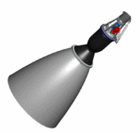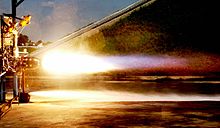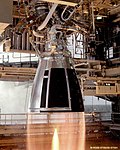SpaceX Kestrel
 SpaceX Kestrel | |
| Country of origin | United States |
|---|---|
| Manufacturer | SpaceX |
| Application | upper stage boost |
| Liquid-fuel engine | |
| Propellant | LOX / RP-1 |
| Cycle | pressure fed |
| Performance | |
| Thrust, vacuum | 6,900 pounds-force (31 kN) |
| Thrust-to-weight ratio | 65 |
| Chamber pressure | 135 pounds per square inch (930 kPa) |
| Specific impulse, vacuum | 317 s (3.1 km/s) |
| Dimensions | |
| Dry mass | 52 kilograms (115 lb) |
| References | |
| References | [1][2][3] |

The Kestrel engine is an LOX/RP-1 pressure-fed rocket engine. The Kestrel engine was developed by SpaceX for upper stage use on the Falcon 1 rocket.
Kestrel was built around the same pintle architecture as the Space X Merlin engine but does not have a turbo-pump and is fed only by tank pressure.
Kestrel is ablatively cooled in the chamber and throat and radiatively cooled in the nozzle, which is fabricated from a high strength niobium alloy. As a metal, niobium is highly resistant to cracking compared to carbon-carbon. According to SpaceX, an impact from orbital debris or during stage separation might dent the metal but have no meaningful effect on engine performance.[4] Helium pressurant efficiency is substantially increased via a titanium heat exchanger on the ablative/niobium boundary.[5]
Thrust vector control is provided by electro-mechanical actuators on the engine dome for pitch and yaw. Roll control (and attitude control during coast phases) is provided by helium cold gas thrusters.
A TEA-TEB pyrophoric system is used to provide multiple restart capability on the upper stage. In a multi-manifested mission, this allows for drop off at different altitudes and inclinations.
Kestrel 2
Enhancements to the design of the original Kestrel engine are planned. Changes will include tighter tolerances to improve consistency, higher Isp, and lighter weight.[6]
See also
References
- ^ "Falcon 1 Users Guide" (PDF). SpaceX. 2008-09-28.
- ^ spachelaunchreport.com - falcon
- ^ astronautix
- ^ Greg Zsidisin (23 March 2007). "SpaceX Confirms Stage Bump On Demoflight 2". Space Daily. Retrieved 2008-09-30.
- ^ "Falcon 1 Flight Three Press Kit" (PDF). SpaceX. Retrieved 2008-09-30.
- ^ Bergin, Chris (2007-09-24). "Elon Musk Q and A - Updates SpaceX status on Falcon and Dragon". NASAspaceflight.com. Archived from the original on 2008-05-29. Retrieved 2008-06-16.
{{cite web}}: Unknown parameter|coauthors=ignored (|author=suggested) (help)

